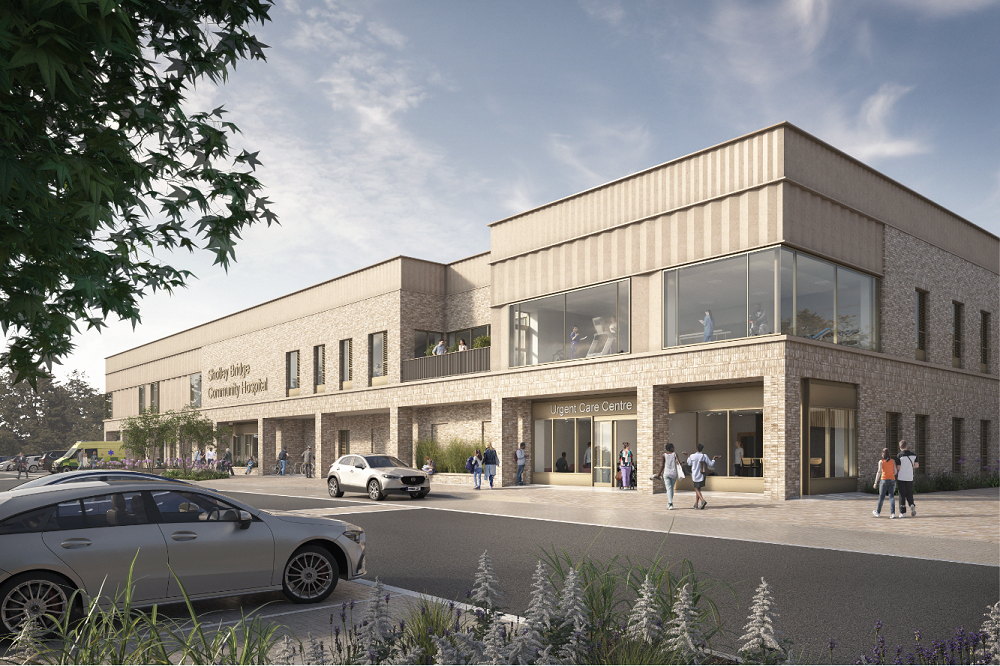Biophilic design and access to nature key to proposed new facility

Plans for one of the first projects to be delivered in the second wave of the Government’s New Hospital Programme (NHP) have been approved.
Proposals for a new community hospital in Consett, designed by Medical Architecture for County Durham and Darlington NHS Foundation Trust, were unanimously approved by Durham’s strategic planning committee.
The project is in Cohort 2 of the NHP, the plan by NHS England & NHS Improvement to deliver 40 new healthcare facilities by 2030.
Arranged around two large landscaped courtyards, the new hospital will offer a range of facilities including outpatient services and diagnostics, an urgent care centre, a medical investigations unit for cancer services alongside a chemotherapy day unit, family health services, and a 16-bed rehabilitation inpatient ward.
Making an entrance
A primary entrance at the front of the building will provide access to the inpatient ward and outpatient departments, while a pedestrian entrance on the opposite side connects directly with a proposed new footpath.
These are connected by a central public concourse through the building with a public café and clear wayfinding to all facilities.
A simple plan, arranged around the two courtyards, brings natural daylight deep into the heart of the building and offers almost all occupied rooms an outside view.
Shotley Bridge has been identified as a Cohort 2 development in the NHP and we look forward to continuing discussions with our NHS colleagues and the local communities and progressing the scheme over the next few years
The courtyard spaces, with landscape design by ONE Environments, will feature planting which is rich in texture, form and colour, and designed with unique characters for different purposes.
The ‘Serenity Garden’ is accessible to visitors, patients, and staff, and features a mixture of open and semi-private seating spaces so people can rest comfortably with family and friends.
And the ‘Healing Garden’ has been developed in collaboration with clinical staff as a private, therapeutic space available to patients and staff to aid and assist rehabilitation.
A culture of care
Internally, biophilic design principles create an uplifting and non-institutional healthcare environment by providing direct and indirect connections to nature.
As well as benefiting patients, this also promotes wellbeing in the workplace and supports a positive culture of care.
And sustainability is at the heart of the design, with the wider site masterplan and hospital development encouraging more-sustainable means of transport through the inclusion of a new pedestrian and cycle link connecting with the Coast-to-Coast path that runs adjacent to the site, and a new footpath leading from the town centre.
Sitting at the entrance of a wider site masterplan envisioned as a parkland, the idea of a ‘pavilion in the park’ was a key design concept for the new hospital.
This is reflected in the human-scale building form, careful composition of a simple material palette, and a landscaping strategy that promotes biophilic interactions and a harmonious relationship with the site’s context.
Sustainability at the heart
The hospital has been designed to achieve BREEAM ‘Excellent’ sustainability rating and adopts the NHS’s Net Zero Carbon standards as a guiding principle.
And longevity has been prioritised with flexibility and adaptability to ensure the hospital can accommodate changing models of care and service delivery.
We have designed a building that is welcoming to all and that creates an environment for care that promotes wellbeing and recovery
Principles of standardisation and repeatability have also been adopted to optimise efficiencies and ensure future adaptability in the building layout.
In addition, the project is also committed to utilising modern methods of construction (MMC).
Working alongside MMC consultants, Akerlof, the design team has adopted a framework of core principles, which include design for manufacture and assembly and the use of prefabricated systems and offsite manufactured components.
Lianne Knotts, director at Medical Architecture, said: “We are delighted to move on to the next stage in delivering this important new community hospital for the local population.
“We have designed a building that is welcoming to all and that creates an environment for care that promotes wellbeing and recovery.
“We are now looking forward to making the plans a reality.”
Jane Curry, programme manager for County Durham and Darlington NHS Foundation Trust, added: “This an exciting development for the local population in Derwentside and the wider County Durham healthcare community.
“Shotley Bridge has been identified as a Cohort 2 development in the NHP and we look forward to continuing discussions with our NHS colleagues and the local communities and progressing the scheme over the next few years.”
The hospital will be built by contractor, Tilbury Douglas.
Project Team